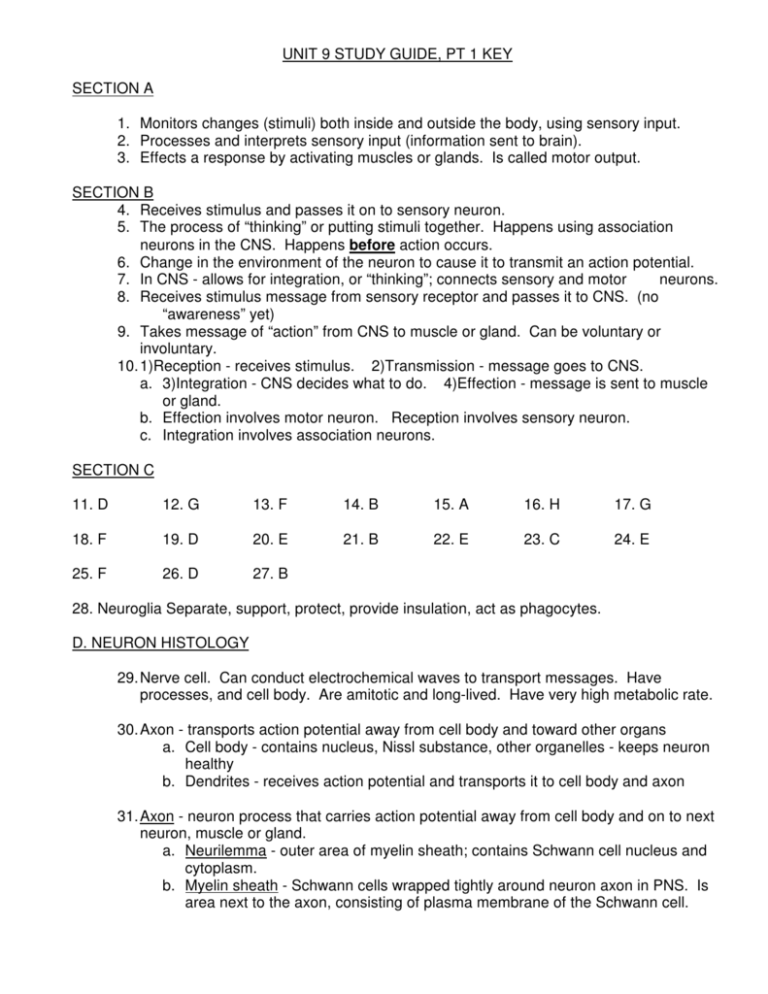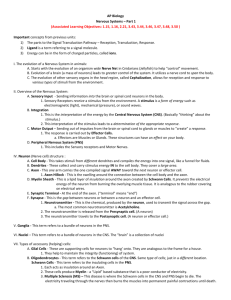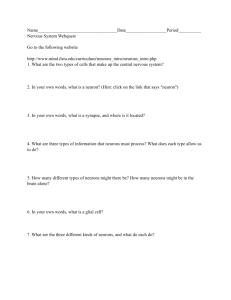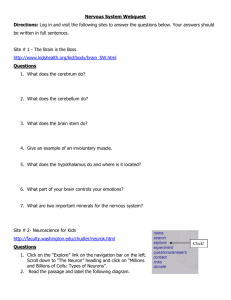UNIT 9 STUDY GUIDE, PT 1 KEY SECTION A 1. Monitors changes
advertisement

UNIT 9 STUDY GUIDE, PT 1 KEY SECTION A 1. Monitors changes (stimuli) both inside and outside the body, using sensory input. 2. Processes and interprets sensory input (information sent to brain). 3. Effects a response by activating muscles or glands. Is called motor output. SECTION B 4. Receives stimulus and passes it on to sensory neuron. 5. The process of “thinking” or putting stimuli together. Happens using association neurons in the CNS. Happens before action occurs. 6. Change in the environment of the neuron to cause it to transmit an action potential. 7. In CNS - allows for integration, or “thinking”; connects sensory and motor neurons. 8. Receives stimulus message from sensory receptor and passes it to CNS. (no “awareness” yet) 9. Takes message of “action” from CNS to muscle or gland. Can be voluntary or involuntary. 10. 1)Reception - receives stimulus. 2)Transmission - message goes to CNS. a. 3)Integration - CNS decides what to do. 4)Effection - message is sent to muscle or gland. b. Effection involves motor neuron. Reception involves sensory neuron. c. Integration involves association neurons. SECTION C 11. D 12. G 13. F 14. B 15. A 16. H 17. G 18. F 19. D 20. E 21. B 22. E 23. C 24. E 25. F 26. D 27. B 28. Neuroglia Separate, support, protect, provide insulation, act as phagocytes. D. NEURON HISTOLOGY 29. Nerve cell. Can conduct electrochemical waves to transport messages. Have processes, and cell body. Are amitotic and long-lived. Have very high metabolic rate. 30. Axon - transports action potential away from cell body and toward other organs a. Cell body - contains nucleus, Nissl substance, other organelles - keeps neuron healthy b. Dendrites - receives action potential and transports it to cell body and axon 31. Axon - neuron process that carries action potential away from cell body and on to next neuron, muscle or gland. a. Neurilemma - outer area of myelin sheath; contains Schwann cell nucleus and cytoplasm. b. Myelin sheath - Schwann cells wrapped tightly around neuron axon in PNS. Is area next to the axon, consisting of plasma membrane of the Schwann cell. c. Nodes of Ranvier - spaces between Schwann cells in the myelin sheath. They help speed up transmission of the impulse. 32. Schwann cells occur in PNS. Plasma membranes are very fatty and provide insulation for the neuron. They also separate, support and become phagocytes when they need to get rid of old, worn cell parts. They allow neuron to regenerate parts of its axon (PNS only) if necessary. 33. Axon - only 1 - transports message away from cell body Dendrite - often many - trnasports message toward cell body 34. Rough endoplasmic reticulum. It produces and packages proteins for the remaking of new cell parts - expecially important since neurons are amitotic (don’t divide) and need new cell parts for years. 35. Multipolar - many dendrites attached to cell body and 1 axon extending from cell body. Are in CNS and are found in motor division of PNS. Unipolar - cell body off to the side; long axon with short dendrites on distal end. Are in PNS as sensory neurons.(Bipolar - one dendrite going to cell body; one axon leaving cell body.) 36. Bundle of nerve fibers or neurons (especially axons) traveling together. Is an organ. 37. Repairing injured parts. PNS. SECTION E 38. An environmental stimulus or neurotransmitter opens sodium gates causing depolarization. 39. At rest- sodium is found outside the cell and potassium is inside making the overall charge positive outside, negative inside. Sodium and potassium channels are closed. a. Depolarization- A stimulus from the environment or a neurotransmitter from another neuron opens sodium gates, causing sodium to move into the cell; the inside becomes positive charged, outside negative b. Repolarization- the cell returns the charges to normal by opening potassium gates. Potassium leaves the cell making the outside positive again and the inside negative. c. Restoration- A sodium potassium pump uses ATP to pump potassium back into the cell and sodium out; maintaining the charges, but returning ions to their original position d. Synapse- at the end of the neuron, a neurotransmitter is released. It travels across the synaptic cleft and binds to a receptor in the muscle, a gland or another neuron to start a new action potential. 40. When the neuron is repolarizing and pumping ions and can’t transmit an action potential. 41. The axon terminal of one neuron, the gap, and the dendrite of the next neuron.(Can also be surface of a muscle or gland that receives the neurotransmitter.) 42. Synaptic gap. It transmits the neurotransmitter from the axon terminal to the dendrite to pass on the action potential. The neurotransmitter is then degraded by enzymes so the message stops being sent, unless new neurotransmitter is released. It also allows message to be sent in only one direction. 43. The chemical released by the axon terminal of a neuron. It travels to a dendrite, muscle, or gland and sets up another action potential at the new organ, thereby transmitting the message. 44. The message is sent to a muscle or gland to create an “action” or effect. 45. To maintain homeostasis 46. How fast a neuron will transmit an action potential. 47. Thick, myelinated neurons transmit at 100 m/sec. Small, unmyelinated neurons transmit at 0.5 m/sec. 48. Saltatory conduction - action potential (nerve impulse) jumps from one node of Ranvier to the next. Is very fast. Continuous conduction - action potential moves directly along the axon. Is slower. SECTION F 49. Keeps neuron membrane form being as permeable to Na, so is hard to generate an action potential. 50. No. Ca++ is needed for the neuron to transmit impulses; it helps in the active transport of the Na+ and K+ ions, by keeping Na/K gates closed except when pumping. 51. The myelin sheaths gradually disentigrate in the PNS. 52. Alcohol anesthetizes you, so the aching caused by the cold in fingers, toes, etc. is not felt. You aren’t “warmed up”, but you don’t know you are getting cold, and you can get severe frostbite.









